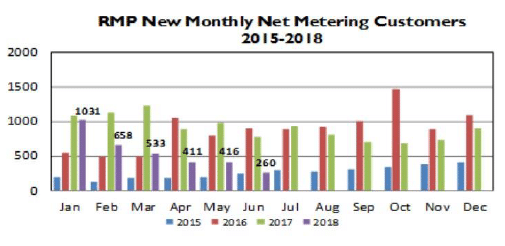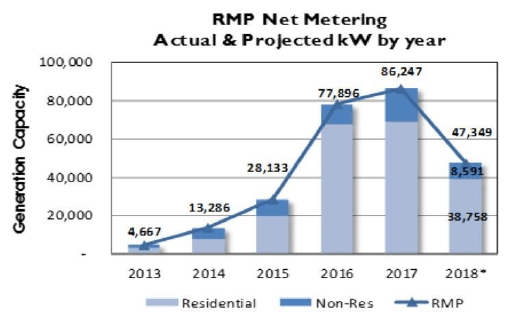New data seen by pv magazine indicates that Utah’s once-robust rooftop solar market has significantly declined following changes to net metering.
Exact details have been hard to come by, as utility Rocky Mountain Power (RMP) has provided data in a piecemeal manner. However, according to an RMP chart sent to pv magazine, the utility saw only 1,087 customers installing distributed renewable energy (almost exclusively rooftop solar) under net metering in the second quarter of 2018, a fall of more than half from the first quarter. It is also far less than in 2016 or 2017, which saw more than 10,000 net metering installations each year.

This is across all of RMP’s territory, however the vast majority of customers installing solar have been in Utah.
Meanwhile, a successor program does not appear to be picking up the slack. According to a recent report filed with the Utah Public Service Commission, only 212 customers had signed up to install solar under the utility’s “transition program” by April 1.
Last fall, the Utah Public Service Commission approved a deal between Rocky Mountain Power and solar advocates. Under this settlement, all residents who applied for the state’s net metering program by November 14, 2017 have one year to complete their PV installations and will be grandfathered into the system and receive full retail rate net metering.
Customers who send in an application after that date and before October 1, 2020 will be considered transition customers in the “Export Credit Proceeding” program. Under this program, the state’s residential solar tax credit program was extended through 2024, with customers receiving a $1,600 credit from 2018-2020 and credits reduced by $400 annually in the following 3 years before the 2024 expiration date.
But instead of the 1:1 credit for excess energy production under net metering, customers will receive a credit of 92% of the retail value of their electricity, measured in the time frame of 15-minute intervals. That means that solar generated during the day, when most residential customers are at work, will be credited at a reduced rate.
It may be too early to gauge the success of the new program, given that most of the solar installations for the first half of 2018 were leftover net metering installations for customers who got in an application before the deadline. And while the Q1 numbers provided by RMP were not encouraging, it is unclear if this market disruption is a temporary market adjustment or an indication of more serious problems.
Utah Solar Energy Association has described the deal as a win in that it avoided the worst-case scenario, but at least one solar professional does not agree. “They truncated our value proposition,” states Alan Naumann of Affiliate Solar and EV Structures. He notes that two solar companies have already gone out of business since the change, and that “most of them are struggling”.
And unless the transition program picks up, the industry is likely to see further losses. RMP estimates only half the net metering installations this year as opposed to last year, predicting that only 47 MW will be installed under the program, instead of the 86 MW in 2017 and 78 MW the year prior.

A successor policy to net metering is still being crafted, which means that there is further uncertainty in Utah’s solar market as to what happens after the transition program ends.
Employment dangers
This potential downtick in installations represents a troubling trend in one of the nation’s leading solar states, especially for employment. Utah ranks 12th in the nation in terms of jobs in the solar industry and 4th when it comes to installation jobs, according to The Solar Foundation’s 2017 Solar Jobs Census. Utah also ranks 4th in solar jobs per capita and is home to the headquarters of Vivint Solar, the nation’s third-largest residential solar company.
But while the state’s rooftop solar segment has struggled, large-scale solar has thrived in Utah. The state has reached 9th in terms of installed capacity at 1,616 MW, up from 19th in 2017, according to SEIA.
SEIA has predicted that Utah will have the 12th-highest projected growth in the nation. Hopefully the state’s separation from net metering and downtick in installations don’t compromise this forecast.
This content is protected by copyright and may not be reused. If you want to cooperate with us and would like to reuse some of our content, please contact: editors@pv-magazine.com.









By submitting this form you agree to pv magazine using your data for the purposes of publishing your comment.
Your personal data will only be disclosed or otherwise transmitted to third parties for the purposes of spam filtering or if this is necessary for technical maintenance of the website. Any other transfer to third parties will not take place unless this is justified on the basis of applicable data protection regulations or if pv magazine is legally obliged to do so.
You may revoke this consent at any time with effect for the future, in which case your personal data will be deleted immediately. Otherwise, your data will be deleted if pv magazine has processed your request or the purpose of data storage is fulfilled.
Further information on data privacy can be found in our Data Protection Policy.